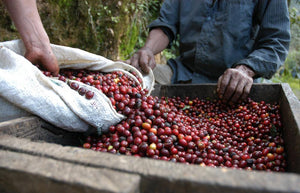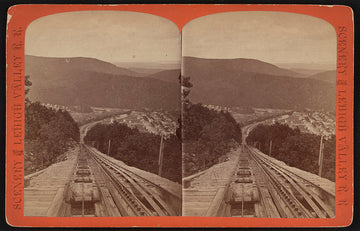Seed to Cup: The Journey of Coffee
Sometimes, the simplest things, like our morning cup of coffee, are the most intricate. Coffee "beans" are actually seeds - and they are the product of a long and complicated journey, involving the work of multiple artisans, that spans multiple continents. Whether you're a budding barista, a home connoisseur, or totally new to coffee, this article will help you better understand coffee's seed to cup process.
The Coffee Chain
The coffee industry is often referred to as the coffee chain. The coffee chain is a long series of links that rely on one another to move this agricultural product along its journey. If one of the links in the coffee chain fails, the entire system takes a blow.
Each link in the coffee chain is an important step that takes coffee from its very first moments as a seed to its final show as a brewed beverage. This journey spans years of dedicated work and many thousands of miles across the globe.
Starting with the farmers that nurture the coffee seed into a fruit-producing coffee tree and ending with the careful brewing of roasted beans. Every step is crucial to building and maintaining the quality of the product from seed to cup.
From the Earth
The coffee chain begins and ends with a seed. It is always important to remember that coffee is, at its most basic, an agricultural product. This agricultural product is dynamic and subject to change based on so many factors.
Of course, it all begins with the bean itself.
Meet the Bean
Though often referred to as beans or simply coffee, the final product that we roast, grind and brew is the seed of the coffee plant.
Coffee plants, also known as coffee trees, are evergreen shrubs. This means that they flourish between 4 and 7 feet and have leaves year-round. Coffee plants are best kept within the 5-6 foot height range to keep the coffee cherries accessible - more on this later.
But first, what are coffee cherries? Coffee cherries at the fruit of the coffee plant.
Generally speaking, inside of each coffee cherry are two coffee seeds (or beans, as we know them). The coffee cherries are generally the size and color of cranberries, however, the flesh of the coffee cherry is sweet and somewhat vegetal.
The coffee cherry is made up of the exterior skin, the fruit flesh, the mucilage, and the parchment that surrounds the seed. The mucilage is the gooey layer between the fruit flesh and the outer skin of the seed.
All parts of coffee cherries play a vital role in the flavor and quality of the coffee beans both during the growing period and during processing.
Species and Varieties
There is more to coffee than a single species or plant. There are two commercial growing species of coffee, Coffea arabica and Coffea robusta, often referred to as arabica and robusta, respectively.
The quality of Arabica coffee is - generally - vastly superior to Robusta coffee. However, there are always exceptions and not all Arabica coffee is high quality, nor is all Robusta low quality.
Moreover, there are many varieties of each species, each with its unique qualities that contribute to flavor, growing quality, and other characteristics of the seed.
As with apples or wine, varieties (also known as varietals) become known for their specific traits. For example, Granny Smith apples are tart with green skin while Red Delicious are sweeter with red skin. They are both still apples and have similarities but are starkly different in other ways.
The same concept holds true for coffees. Coffee varietals, despite their differences, carry similarities as well as unique flavor profiles.
While there is no need to run off and study each varietal and its characteristics, it is a good idea to familiarize yourself with coffee varietals as you brew and taste different coffees.
Understanding Terroir
Varieties contribute massively to the final product that we grind and brew each morning. With that said, varieties are not the sole contributor to flavor.
Terroir (pronounced teuh-waa) is a term that food and agriculture industries use to describe the growing environment of a product. You’ll often hear terroir discussed in the context of wine, coffee, and botanical liquors like gin.
Simply put, terroir is all about where and how the coffee is grown.
For example, some factors in coffee terroir include elevation, soil content, growing medium and soil content, weather conditions and climate, processing, and the varietal of the coffee.
You may have noticed that many of these factors are environmental. There are, however, some factors that are influenced by coffee producers. Terroir is not limited simply to natural occurrences but also includes the choices made by the producers.
Beyond the initial growing environment of the coffee, one such choice that producers must make is how to harvest the coffee cherries.
Harvesting
Harvesting coffee cherries is an integral link in the seed to cup coffee chain. This moment is a turning point in the entire process and can make or break the quality of the product.
Up until this point in the growing process, producers have been investing time, finances, and so much more into building the quality of the coffee trees and their produce. With all of that effort and energy invested into the coffee cherries, it is so important to preserve that quality.
It is important to note that coffee cherries ripen non-uniformly. This means that on one branch, there will be ripe cherries, underripe cherries, and overripe cherries. Ideally, a harvest should only include perfectly ripe cherries, leaving the underripe cherries on the branch to continue to ripen and overripe cherries to fall to the ground as compost.
Because of this ripening process, coffee harvest usually consists of multiple passes over a few weeks. This means that pickers will harvest one round of ripe cherries and return to harvest the remaining cherries as they continue to ripen.
Harvesting cherries at their perfect ripeness is important as it captures all of the best flavors of the coffee cherry and instills that quality into the coffee seed.
Different harvesting methods yield different results. Some harvesting methods are much faster than others but will lower the quality of the fruit harvested. Other methods are time-consuming and less cost-effective but do not compromise the quality of the harvest.
Strip-Picking
Strip-picking is the process of removing all of the coffee cherries from the tree in one pass. Strip-picking can be done by hand or by machine and is a faster method of harvesting the coffee cherries.
This method increases the yield of the harvest but greatly decreases the quality of the harvest. Because strip-picking removes all of the cherries in one go, the yield will include ripe cherries, underripe cherries, and overripe cherries. The mixture of different levels of ripeness will muddle the flavors of the coffee.
Processing and roasting a bag of mixed ripeness cherries is comparable to eating a ripe strawberry, underripe strawberry, and a rotten strawberry all at once. The underripe and overripe strawberry cancels out the delicious experience of a perfectly ripe strawberry.
The same is true for coffee cherries which is why strip-picking, though less expensive, does not produce high-quality coffees.
Selective-Picking
In contrast to strip-picking, selective-picking can only be done by hand. Selective-picking requires the pickers to select only the ripe cherries, avoiding the overripe cherries and leaving the underripe cherries to continue to ripen.
This allows the producers to make multiple passes at the coffee trees, harvesting only the cherries that are ripe and ready. By doing so, they are ensuring that the cherries are at peak quality.
This picking method is more expensive due to the intense labor and extensive time spent harvesting. However, it greatly affects the quality of the coffee and is absolutely necessary for any specialty-grade coffee.
The Processing Spectrum
Once the coffee is harvested, it must be processed. Processing is done in a variety of ways that exist on a spectrum. Producers are constantly adjusting and discovering processing methods that manipulate and elevate the final flavors in roasted coffee.
Coffee Mills
The first stop during processing is the coffee mill. Some farms will mill the coffee onsite while others will use a community or commercial mill.
Milling coffee is done different dependent on the chosen process but the concept remains the same. Coffee milling removes the fruit flesh and mucilage from the coffee seeds while sorting out debris from the coffee. The coffee is then bagged and will either be stored at the mill or a nearby facility to age for a few months before shipment.
The process varies but generally the coffee cherries are fermented with or without water, hulled, sorted, and bagged. Some of this is done by hand but mostly machinery is utilized to make the entire process more efficient.
Washed Process
Washed coffees are processed with the use of water from the very start. The coffee cherries enter into a system that uses water and mechanical agitation to sort out denser materials, such as stones and twigs, while removing the fruit flesh and mucilage from the seeds.
The seeds are then fermented in water for up for anywhere between 10 hours to 48 hours - of course, there are producers that work outside of these generalizations.
The coffee seeds are then laid out to dry in raised beds or on a patio. Sometimes the drying process is done in a temperature and humidity controlled environment so as to ensure a specific water content for the final product.
After processing, but before roasting, coffee is called green coffee or simply green.
Dry Process
Dry process coffees, also known as natural process coffees, are very different from washed process coffees. The dry process does not utilize water to wash the fruit flesh away but rather leaves the fruit flesh on during the fermentation process.
The coffee cherries are laid out to dry immediately without any contact with water for 5-10 days. With the fruit still intact, the fermentation process begins. For this reason, dry process coffees tend to have very jammy, fruity flavors.
After the fermentation is completed, the dried coffee cherries are brittle enough to undergo hulling without any water contact. Instead, the dried fruit flesh is removed with dry mechanical agitation.
As with any other process, the coffee is sorted and bagged before exporting.
Exporting and Importing
An often overlooked step in the coffee chain, exporting and importing coffee is a vital step in coffee’s journey. Exporters and importers facilitate the movement of coffee from producers at origin to roasters around the world.
Traders are responsible for arrange the export and import of the green coffee, grading and assessing, as well as curating coffee selections for roasting companies.
Grading
Grading coffee is not limited to traders and is practiced by all members of the coffee industry. The purpose of grading coffee is to evaluate a coffee objectively and provide a score that is universally understood.
The most well known grading system is that of the Specialty Coffee Association’s. The SCA has a 100 point grading system that allows coffee professionals to assess coffees in a uniform way across the globe.
If a coffee scores above 80, it is generally considered specialty coffee. However, this score is often viewed as a guideline and is not the make or break of the coffee and its success.
The Roaster’s Journey
Green coffee makes its way from origin countries to the traders’ warehouses before it eventually makes its way to roasteries around the world. Traders facilitate this process by providing roasters with information and samples or by hosting tasting sessions.
Roasters must decide which coffees best suit their offerings and audience. This can be tricky as every coffee is unique and will bring different flavors to the table. It’s crucial that roasters provide a diverse set of coffees to please every palate.
Understanding the Roasting Process
The roasting process is a mixture of art and science. Every coffee roaster machine is unique and requires constant cleaning and maintenance. It is the job of the head roaster and their staff to keep the equipment in excellent condition so as to ensure the quality of the roast.
In addition to keeping up with the equipment needs, roasters must formulate specific roast profiles for each coffee. Roasting coffee is a different process for every bean. Just like with baking bread or cakes, with every different recipe come different ingredients and bake time.
A dry processed Rwandan coffee will roast very differently than a washed process Colombian coffee. It is the roasters responsibility to learn how to predict these differences and create unique recipes, or roast profiles, for every coffee.
In general, the actual roasting process requires green beans to be loaded into a large drum within which heat is applied as the beans rotate in the drum. The roaster dictates the temperature throughout the process and controls the speed and time of the roast. These factors combine to create different types of roasts and different flavors in the final bean.
For example, a short roast at a higher temperature will produce an intense and smokey dark roast, whereas a longer roast at lower temperatures will produce a more complex light roast.
Brewing the Bean
At last the roasted coffee has arrived at the café or in your very own kitchen. It’s time to brew.
But where to begin? There are so many possibilities when it comes to brewing coffee. Will you choose a pour over? A french press? An automatic drip or, perhaps, cold brew?
There are so many options for a reason. Each coffee shines differently and some are better suited for certain brew methods. Next time you bring home a coffee from your local roaster, try out different brew methods and ratios to see what you enjoy the most.
Brew ratios can vary greatly dependent on the recipe, brew methods, and the beans. The best advice we can give is to ask your barista or roaster what their preferred recipe is. Otherwise, start out at 1:16 ratio if using grams (that’s about 2 tablespoons per 6oz water).
We also recommend grinding your coffee at home. Whole bean coffee retains its freshness and quality much longer than pre-ground coffee. With your own grinder, you can adjust your grind setting to suit each unique brewer.
Additionally, a burr grinder is far superior to blade grinders. Burr grinders evenly grind the coffee with precision whereas blade grinders chop the beans into various sizes without any precision.
Honor the Bean, Acknowledge the Journey
The most important takeaway after discovering the epic journey that coffee undergoes is to acknowledge the effort and commitment it takes to do so.
On average, 60 different pairs of hands touch coffee before it lands in your cup. That includes farmers, pickers, mill workers, sailors, traders, truck drivers, roasters, baristas, and so many other.
Every time you take a sip of coffee or brew a new roast at home, take a moment to acknowledge the coffee chain. Be intentional with your enjoyment of coffee whether you are at home or your local café. Honor the bean.




1 comment
I appreciate all the knowledge you share in your blog 😊